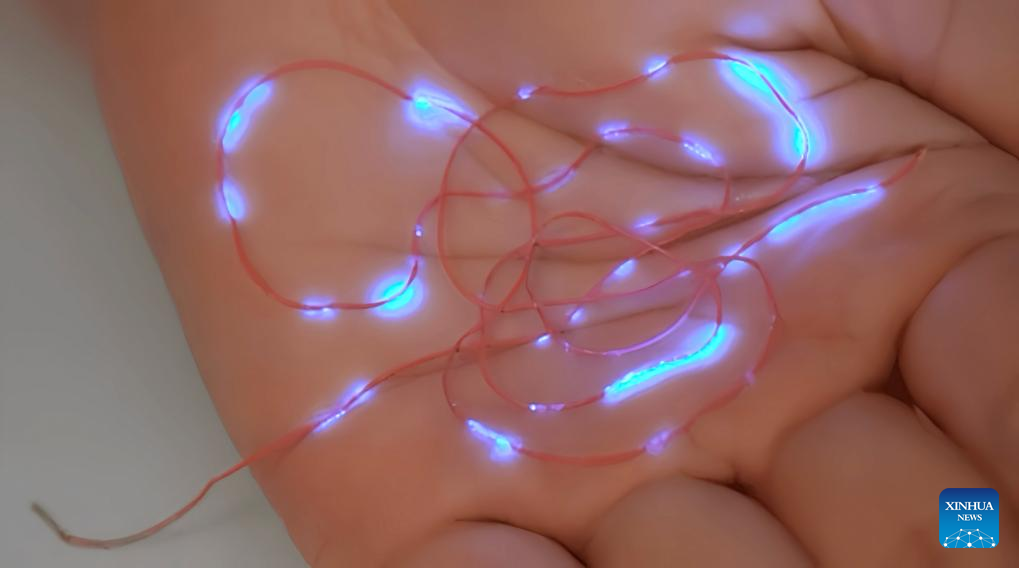Your current location:HOME >health >Across China: Chinese researchers develop new luminous smart fiber 正文
TIME:2024-04-30 07:39:35 Source: Internet compilationEdit:health
A researcher shows the luminous mechanism of new smart fiber at Donghua University in Shanghai, east

A researcher shows the luminous mechanism of new smart fiber at Donghua University in Shanghai, east China, in March 2024. (Donghua University/Handout via Xinhua)
SHANGHAI, April 7 (Xinhua) -- A Chinese research team has developed a new type of smart fiber that can emit light and generate electricity without being plugged in.
The fiber integrates functions including wireless energy collection, information perception and transmission, and can be made into textiles that can realize human-computer interaction functions such as luminous display and touch control without chips and batteries.
The study, recently published in the journal Science, is expected to change the way people interact with the environment and between people, and is of great significance for the application of smart textiles.
Smart wearable devices have become part of daily life and play an important role in health monitoring, telemedicine, human-computer interaction and other fields.
Compared with traditional rigid semiconductor components or flexible thin film devices, electronic textiles made of smart fibers are more breathable and softer.
However, the current development of smart fibers uses complex multi-module integration, which increases the volume, weight and rigidity of textiles.
A research team from Donghua University's College of Materials Science and Engineering accidentally discovered that fibers emitted light in a radio field during an experiment.
Based on the findings, the team developed a new type of smart fiber that uses electromagnetic energy as a wireless driving force.
This new type of fiber is featured with cost-effective raw materials and mature processing technology, said Yang Weifeng, a member of the research team.
It can realize fabric display, wireless instruction transmission and other functions without using chips and batteries.
Clothes made of the new fibers can be interactive and luminous, and can also remotely control electronic products wirelessly by generating unique signals for different postures of users, said Hou Chengyi, a researcher at Donghua University.
The research team said that they will further study how to make the new fiber collect energy from space more effectively to develop more functions including display, deformation, and computing. ■
DPRK successfully test2024-04-30 07:27
Thierry Henry blames Declan Rice for Bayern Munich's opener at the Emirates2024-04-30 07:20
Venezuelan beauty queen Wilevis Brito, 24, dies following surgery on jaw and lip2024-04-30 07:17
There's the Wallys! Darts fans brawl in the crowd2024-04-30 06:59
Nadal tested in 32024-04-30 06:55
Forget the World Cup, Euros or Super Bowl2024-04-30 06:27
Kris Jenner, 68, looks chic in D&G dress for 'date night' with longtime boyfriend Corey Gamble, 432024-04-30 06:16
Bridgerton fans are all saying the same thing about season 3's costumes as new trailer drops2024-04-30 06:06
Thai FM offers to resign after cabinet reshuffle2024-04-30 05:37
Bayern Munich kick a ball around a £3,5002024-04-30 05:13
Scarred UNESCO World Heritage site Jiuzhaigou recovers after quake2024-04-30 07:30
PLAYER RATINGS: Scores revealed for DIRE Liverpool stars who flopped in first leg against Atalanta2024-04-30 07:14
Immigration declines nearly half of study visa applications from India so far this year2024-04-30 07:10
Venezuelan beauty queen Wilevis Brito, 24, dies following surgery on jaw and lip2024-04-30 07:06
Chinese citizen killed, another wounded in mass stabbing attack at Sydney mall2024-04-30 06:53
Blake Lively says she dreamed up husband Ryan Reynolds as she promotes their new animated film IF2024-04-30 06:39
Australian teen jailed for school shooting2024-04-30 06:25
Katie Holmes cuts a casual figure in a t2024-04-30 06:16
China's archaeological site parks register strong revenue growth2024-04-30 05:47
Ellie Leach breaks down in tears over her cheating ex2024-04-30 05:16